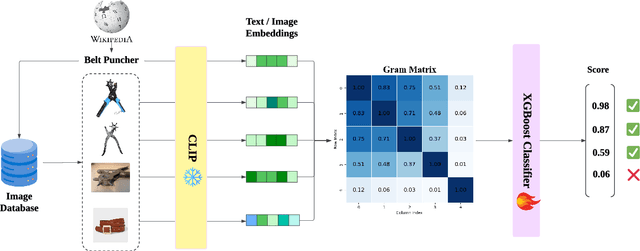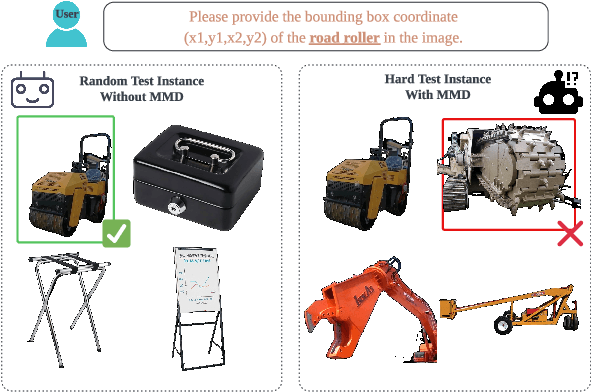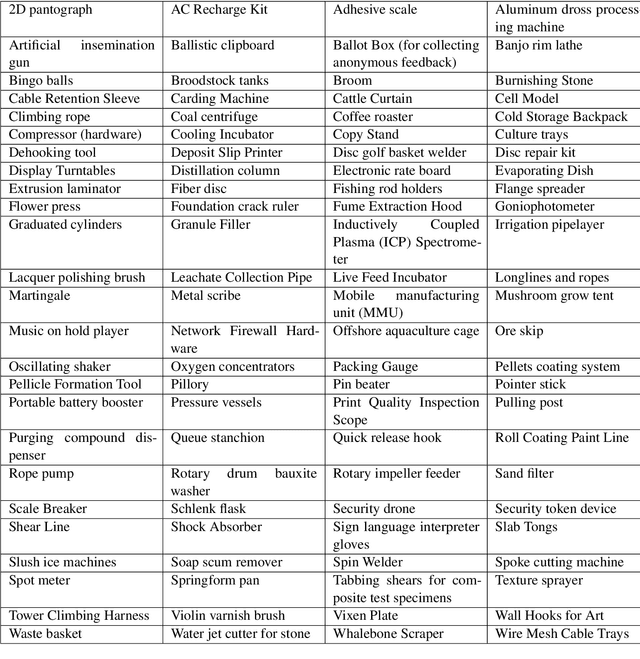Zhiting Hu
Synthesizing Privacy-Preserving Text Data via Finetuning without Finetuning Billion-Scale LLMs
Mar 16, 2025Abstract:Synthetic data offers a promising path to train models while preserving data privacy. Differentially private (DP) finetuning of large language models (LLMs) as data generator is effective, but is impractical when computation resources are limited. Meanwhile, prompt-based methods such as private evolution, depend heavily on the manual prompts, and ineffectively use private information in their iterative data selection process. To overcome these limitations, we propose CTCL (Data Synthesis with ConTrollability and CLustering), a novel framework for generating privacy-preserving synthetic data without extensive prompt engineering or billion-scale LLM finetuning. CTCL pretrains a lightweight 140M conditional generator and a clustering-based topic model on large-scale public data. To further adapt to the private domain, the generator is DP finetuned on private data for fine-grained textual information, while the topic model extracts a DP histogram representing distributional information. The DP generator then samples according to the DP histogram to synthesize a desired number of data examples. Evaluation across five diverse domains demonstrates the effectiveness of our framework, particularly in the strong privacy regime. Systematic ablation validates the design of each framework component and highlights the scalability of our approach.
Training Large Language Models to Reason in a Continuous Latent Space
Dec 09, 2024



Abstract:Large language models (LLMs) are restricted to reason in the "language space", where they typically express the reasoning process with a chain-of-thought (CoT) to solve a complex reasoning problem. However, we argue that language space may not always be optimal for reasoning. For example, most word tokens are primarily for textual coherence and not essential for reasoning, while some critical tokens require complex planning and pose huge challenges to LLMs. To explore the potential of LLM reasoning in an unrestricted latent space instead of using natural language, we introduce a new paradigm Coconut (Chain of Continuous Thought). We utilize the last hidden state of the LLM as a representation of the reasoning state (termed "continuous thought"). Rather than decoding this into a word token, we feed it back to the LLM as the subsequent input embedding directly in the continuous space. Experiments show that Coconut can effectively augment the LLM on several reasoning tasks. This novel latent reasoning paradigm leads to emergent advanced reasoning patterns: the continuous thought can encode multiple alternative next reasoning steps, allowing the model to perform a breadth-first search (BFS) to solve the problem, rather than prematurely committing to a single deterministic path like CoT. Coconut outperforms CoT in certain logical reasoning tasks that require substantial backtracking during planning, with fewer thinking tokens during inference. These findings demonstrate the promise of latent reasoning and offer valuable insights for future research.
Dynamic Rewarding with Prompt Optimization Enables Tuning-free Self-Alignment of Language Models
Nov 14, 2024Abstract:Aligning Large Language Models (LLMs) traditionally relies on costly training and human preference annotations. Self-alignment seeks to reduce these expenses by enabling models to align themselves. To further lower costs and achieve alignment without any expensive tuning or annotations, we introduce a new tuning-free approach for self-alignment, Dynamic Rewarding with Prompt Optimization (DRPO). Our approach leverages a search-based optimization framework that allows LLMs to iteratively self-improve and craft the optimal alignment instructions, all without additional training or human intervention. The core of DRPO is a dynamic rewarding mechanism, which identifies and rectifies model-specific alignment weaknesses, allowing LLMs to adapt efficiently to diverse alignment challenges. Empirical evaluations on eight recent LLMs, both open- and closed-sourced, demonstrate that DRPO significantly enhances alignment performance, with base models outperforming their SFT/RLHF-tuned counterparts. Moreover, the prompts automatically optimized by DRPO surpass those curated by human experts, further validating the effectiveness of our approach. Our findings highlight the great potential of current LLMs to achieve adaptive self-alignment through inference-time optimization, complementing tuning-based alignment methods.
UOUO: Uncontextualized Uncommon Objects for Measuring Knowledge Horizons of Vision Language Models
Jul 25, 2024



Abstract:Smaller-scale Vision-Langauge Models (VLMs) often claim to perform on par with larger models in general-domain visual grounding and question-answering benchmarks while offering advantages in computational efficiency and storage. However, their ability to handle rare objects, which fall into the long tail of data distributions, is less understood. To rigorously evaluate this aspect, we introduce the "Uncontextualized Uncommon Objects" (UOUO) benchmark. This benchmark focuses on systematically testing VLMs with both large and small parameter counts on rare and specialized objects. Our comprehensive analysis reveals that while smaller VLMs maintain competitive performance on common datasets, they significantly underperform on tasks involving uncommon objects. We also propose an advanced, scalable pipeline for data collection and cleaning, ensuring the UOUO benchmark provides high-quality, challenging instances. These findings highlight the need to consider long-tail distributions when assessing the true capabilities of VLMs.
Pandora: Towards General World Model with Natural Language Actions and Video States
Jun 12, 2024



Abstract:World models simulate future states of the world in response to different actions. They facilitate interactive content creation and provides a foundation for grounded, long-horizon reasoning. Current foundation models do not fully meet the capabilities of general world models: large language models (LLMs) are constrained by their reliance on language modality and their limited understanding of the physical world, while video models lack interactive action control over the world simulations. This paper makes a step towards building a general world model by introducing Pandora, a hybrid autoregressive-diffusion model that simulates world states by generating videos and allows real-time control with free-text actions. Pandora achieves domain generality, video consistency, and controllability through large-scale pretraining and instruction tuning. Crucially, Pandora bypasses the cost of training-from-scratch by integrating a pretrained LLM (7B) and a pretrained video model, requiring only additional lightweight finetuning. We illustrate extensive outputs by Pandora across diverse domains (indoor/outdoor, natural/urban, human/robot, 2D/3D, etc.). The results indicate great potential of building stronger general world models with larger-scale training.
LLM Reasoners: New Evaluation, Library, and Analysis of Step-by-Step Reasoning with Large Language Models
Apr 08, 2024Abstract:Generating accurate step-by-step reasoning is essential for Large Language Models (LLMs) to address complex problems and enhance robustness and interpretability. Despite the flux of research on developing advanced reasoning approaches, systematically analyzing the diverse LLMs and reasoning strategies in generating reasoning chains remains a significant challenge. The difficulties stem from the lack of two key elements: (1) an automatic method for evaluating the generated reasoning chains on different tasks, and (2) a unified formalism and implementation of the diverse reasoning approaches for systematic comparison. This paper aims to close the gap: (1) We introduce AutoRace for fully automated reasoning chain evaluation. Existing metrics rely on expensive human annotations or pre-defined LLM prompts not adaptable to different tasks. In contrast, AutoRace automatically creates detailed evaluation criteria tailored for each task, and uses GPT-4 for accurate evaluation following the criteria. (2) We develop LLM Reasoners, a library for standardized modular implementation of existing and new reasoning algorithms, under a unified formulation of the search, reward, and world model components. With the new evaluation and library, (3) we conduct extensive study of different reasoning approaches (e.g., CoT, ToT, RAP). The analysis reveals interesting findings about different factors contributing to reasoning, including the reward-guidance, breadth-vs-depth in search, world model, and prompt formats, etc.
Generating, Reconstructing, and Representing Discrete and Continuous Data: Generalized Diffusion with Learnable Encoding-Decoding
Feb 29, 2024Abstract:The vast applications of deep generative models are anchored in three core capabilities -- generating new instances, reconstructing inputs, and learning compact representations -- across various data types, such as discrete text/protein sequences and continuous images. Existing model families, like Variational Autoencoders (VAEs), Generative Adversarial Networks (GANs), autoregressive models, and diffusion models, generally excel in specific capabilities and data types but fall short in others. We introduce generalized diffusion with learnable encoder-decoder (DiLED), that seamlessly integrates the core capabilities for broad applicability and enhanced performance. DiLED generalizes the Gaussian noising-denoising in standard diffusion by introducing parameterized encoding-decoding. Crucially, DiLED is compatible with the well-established diffusion model objective and training recipes, allowing effective learning of the encoder-decoder parameters jointly with diffusion. By choosing appropriate encoder/decoder (e.g., large language models), DiLED naturally applies to different data types. Extensive experiments on text, proteins, and images demonstrate DiLED's flexibility to handle diverse data and tasks and its strong improvement over various existing models.
MMToM-QA: Multimodal Theory of Mind Question Answering
Jan 16, 2024Abstract:Theory of Mind (ToM), the ability to understand people's minds, is an essential ingredient for developing machines with human-level social intelligence. Recent machine learning models, particularly large language models, seem to show some aspects of ToM understanding. However, existing ToM benchmarks use unimodal datasets - either video or text. Human ToM, on the other hand, is more than video or text understanding. People can flexibly reason about another person's mind based on conceptual representations (e.g., goals, beliefs, plans) extracted from any available data, which can include visual cues, linguistic narratives, or both. To address this, we introduce a multimodal Theory of Mind question answering (MMToM-QA) benchmark. MMToM-QA comprehensively evaluates machine ToM both on multimodal data and on different kinds of unimodal data about a person's activity in a household environment. To engineer multimodal ToM capacity, we propose a novel method, BIP-ALM (Bayesian Inverse Planning Accelerated by Language Models). BIP-ALM extracts unified representations from multimodal data and utilizes language models for scalable Bayesian inverse planning. We conducted a systematic comparison of human performance, BIP-ALM, and state-of-the-art models, including GPT-4. The experiments demonstrate that large language models and large multimodal models still lack robust ToM capacity. BIP-ALM, on the other hand, shows promising results, by leveraging the power of both model-based mental inference and language models.
LLM360: Towards Fully Transparent Open-Source LLMs
Dec 11, 2023



Abstract:The recent surge in open-source Large Language Models (LLMs), such as LLaMA, Falcon, and Mistral, provides diverse options for AI practitioners and researchers. However, most LLMs have only released partial artifacts, such as the final model weights or inference code, and technical reports increasingly limit their scope to high-level design choices and surface statistics. These choices hinder progress in the field by degrading transparency into the training of LLMs and forcing teams to rediscover many details in the training process. We present LLM360, an initiative to fully open-source LLMs, which advocates for all training code and data, model checkpoints, and intermediate results to be made available to the community. The goal of LLM360 is to support open and collaborative AI research by making the end-to-end LLM training process transparent and reproducible by everyone. As a first step of LLM360, we release two 7B parameter LLMs pre-trained from scratch, Amber and CrystalCoder, including their training code, data, intermediate checkpoints, and analyses (at https://www.llm360.ai). We are committed to continually pushing the boundaries of LLMs through this open-source effort. More large-scale and stronger models are underway and will be released in the future.
Language Models, Agent Models, and World Models: The LAW for Machine Reasoning and Planning
Dec 08, 2023Abstract:Despite their tremendous success in many applications, large language models often fall short of consistent reasoning and planning in various (language, embodied, and social) scenarios, due to inherent limitations in their inference, learning, and modeling capabilities. In this position paper, we present a new perspective of machine reasoning, LAW, that connects the concepts of Language models, Agent models, and World models, for more robust and versatile reasoning capabilities. In particular, we propose that world and agent models are a better abstraction of reasoning, that introduces the crucial elements of deliberate human-like reasoning, including beliefs about the world and other agents, anticipation of consequences, goals/rewards, and strategic planning. Crucially, language models in LAW serve as a backend to implement the system or its elements and hence provide the computational power and adaptability. We review the recent studies that have made relevant progress and discuss future research directions towards operationalizing the LAW framework.
 Add to Chrome
Add to Chrome Add to Firefox
Add to Firefox Add to Edge
Add to Edge